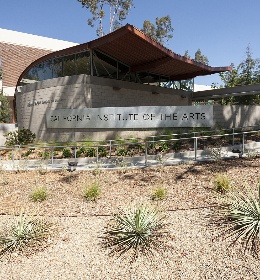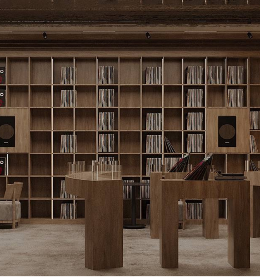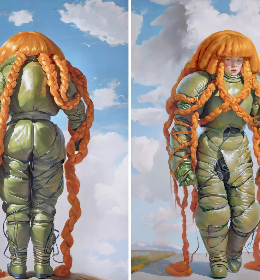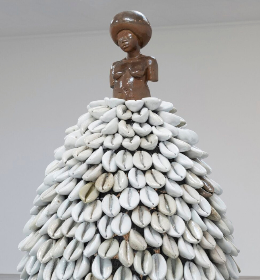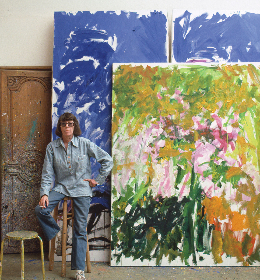The artists have been working together for almost a decade and emphasize the unity of their collaboration, rather than working as individuals dividing tasks. “For us, it’s important to never make such a division. What we work with is establishing different structures to be able to go beyond ourselves and the role of the individual. This is a crucial part of the process, which takes up much of our time, and we never create a work without having put ourselves in that state of being,” says Gideonsson/Londré. I Am Vertical addresses the isolation and mental state experienced when humans go beyond 8,000 meters above sea level into the area of a peak, which climbers call the vertical limit, also referred to as a death zone. Their interest is the exploration of this vertical limit, which they refer to as an island area at the summit, and the effect on the mental state of the climber in this unique area due to isolation, changes in the body in high altitudes, and introspection.
The video is the central part of the installation, which is shown in the Espai 13 - an underground exhibition room - creating a kind of inverted mountain, where even their shoes are attached to a ceiling overhang at the side of the room suggesting that everything is upside down. Gideonsson is seen hanging from a rope, head angled just above the ground, straining to read a text aloud, which lies on the floor underneath her. She appears on a large video screen in a training room, meant to recreate the physical demands of a climb above the vertical limit. She reads poetry with her head cocked to one side, touching the floor, her neck held at a tight angle in what looks to be an agonizing and physically detrimental pose. Gideonsson/Londré explain the work: “It connects to our exploration of different alternative states of being, and also to our work with different experiences of time. For us these two concepts are very close to each other, where the experience of time seems to be what also determines the rest of our experience, and our sense of existing in the world. What we propose in the exhibition is a vertical existence, based on deep time, the effort to strive towards heights and depths and also the “death zone” as a site, both for enlightenment but also destruction. Another important aspect in our work is the language, especially writing and reading in relation to different performative structures, which is also usually seen as a horizontal practice. In this exhibition, we wanted to connect our way of reading and writing to a vertical thinking, and the video installation in the exhibition reflects that process in working with language from an altered vertical position.”
The title of this work, I Am Vertical, comes from a poem by Sylvia Plath. Extrapolating from this connection, Gideonsson/Londré say: “ The poem talks about how our verticality has separated us humans from the rest of nature, which is an interesting claim, and that our drive towards death is also connected to wanting to be more “natural” in some way.” In the video, Gideonsson reads poetry while hanging inverted until she faints, creating a simulated death in terms of enduring the numbness and discomfort in her body and the blood rushing to her head, while she hangs upside down attached to a rope. This work challenges us to understand our own risks and endeavors in the race of life towards death, and the depths and heights of cognitive experience along the way.
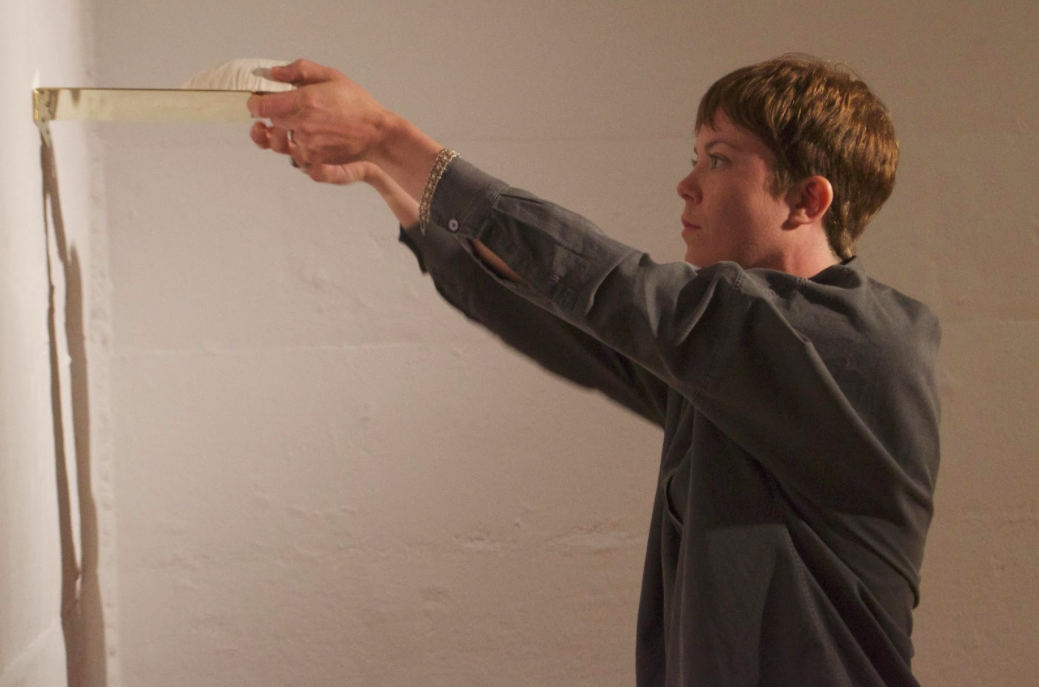
Photo credit Anne Murray, opening performance of I Am Vertical by Gideonsson/Londré
For the opening of the exhibition, they created a short performance in which they stopped to attach their shoes to ceiling straps and then ceremoniously carried molds of the tops of their skulls - the most vertical points of their bodies -, placing them on shelves at either end of a long hallway lined with the same orange gymnasium mats as seen in the video. They expound their concept: “The performance was a way of creating a certain presence in the installation. By leaving our shoes upside down for the rest of the exhibition period, and putting our scalps on the two opposite sides of the corridor, we suggest a sort of stretched out body that is going to stay for the rest of the exhibition. For us it was a way of creating a physical aspect of the space as the visitor has to walk inside of us.”
The exhibition forms the last segment of a year-long curatorial cycle by curator Alexandra Laudo, with each show investigating contemporary views of the island and its metaphorical and physical significance in art and society. “There are many aspects of the island, and what interested us in the vision for the cycle was the possibility to perceive the island more as an isolated structure. To use the island as a way of thinking, more than as an actual place, and instead relating it to our process and method. The concept of the island has an interesting history of being used as an enclosed universe both for fictional and real experiments in social behavior, maybe starting with Thomas More’s Utopia, and this was something that we wanted to continue developing. To establish our own isolated structure to work within, the 14 death zones became our material ground where we could carry out different experiments,” explain Gideonsson/Londré. On the opposite wall to the large video screen, they have created an invisible map using only pin pricks on white paper, each tiny hole representing the 14 most vertical peaks in the world; these tiny islands of uninhabitable space are almost lost in the whiteness of the paper, unless one looks ever so carefully and with the intention to find them.
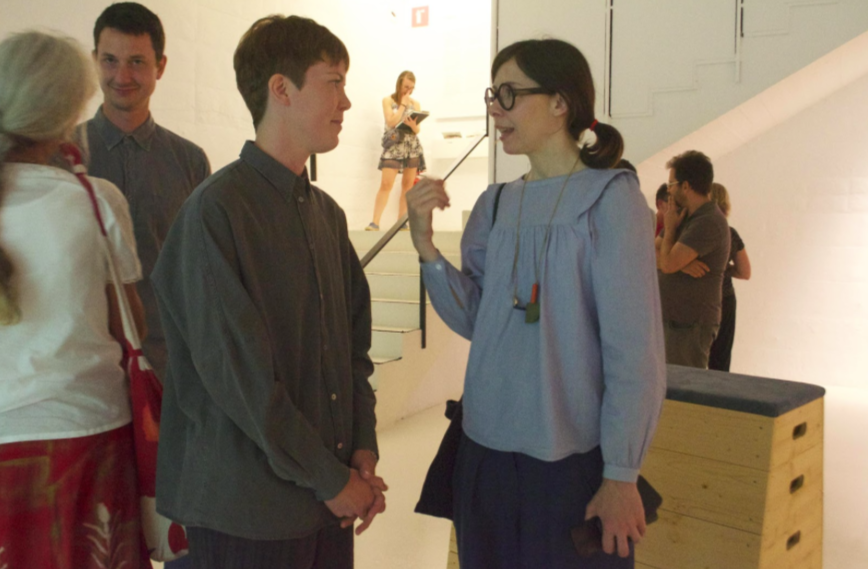
Photo credit Anne Murray, Gideonsson/Londré with curator Alexandra Laudo
The exhibition forms a unique installation combining video, performance and writing, breaking boundaries and limits. It pushes not only the artists themselves, but also the viewers to see and interact with the work in different ways and from different heights, as there are wooden structures which can be used as seats placed in the viewing area facing the video screen. “An important moment in our work was when we started collaborating with the shared interest of breaking boundaries around and between ourselves. This led our attention away from art, and more into other fields where this effort is more evident and comes out of a certain necessity. Working with and within other fields is something which still influences our practice, and makes it hard to talk about our work from the point of view of certain ”combinations." It always looks different,” explains Gideonsson/Londré.
Taking their inspiration not only from texts, such as the poetry of Sylvia Plath, but also from their surroundings - having moved three years ago to a site near the mountains - they say: “We realized quite soon that you always have to relate yourself to the mountains. Maybe they, in some sense, replace other people’s relation to the ocean when looking out at the horizon. Here, the mountain is always the last thing you see, the furthest away.” A poetic vision is revealed in their statement, which simultaneously foretells and recalls the metaphoric nature of their work together.
“The Possibility of an Island” — Exhibition Program at Espai 13 at Fundació Joan Miró
By Anne Murray





